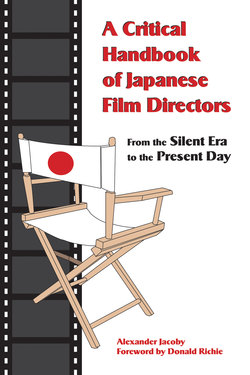Читать книгу A Critical Handbook of Japanese Film Directors - Alexander Jacoby - Страница 23
HARADA Masato
Оглавление(b. July 3, 1949)
原田真人
If Ozu has sometimes been called “the most Japanese of Japanese directors,” then Harada, by common consent, is the most American. During the seventies, he reported from Hollywood for Japanese publications and while there met veteran director Howard Hawks, whose work significantly influenced his own. Harada has set several of his own films in America and elsewhere outside Japan; some have been co-productions, including the German-Japanese Windy (Uindī, 1984), about a racing driver. The U.S.-Japanese co-production Painted Desert (1993) was a curious story set in a Nevada cafe run by a Japanese-American woman, charting her relationship with a local mobster. Also set in America, though filmed in Canada, was Rowing Through (Eikō to kyōki, 1996), about a Harvard rower whose hopes of an Olympic medal are dashed when the U.S. boycotts the 1980 Moscow Games. More recently, Harada played the villainous Omura in Hollywood’s take on the end of the samurai era, The Last Samurai (2003, Ed Zwick).
Like another avowed Hawksian, John Carpenter, Harada appears to have been inspired more by his mentor’s able handling of genre than by his talent for exploring group dynamics. His debut, Goodbye Flickmania (Saraba eiga no tomoyo: Indian samā, 1979), recalled Hawks’ A Girl in Every Port (1928) and was intended as a homage. However, its theme of a film buff unable to tell celluloid from reality set the tone for much of Harada’s later career. The dystopian science fiction film Gunhed (Ganheddo, 1988) was not unlike Carpenter’s 1982 The Thing (itself a remake of a film Hawks produced) in stressing set design, action, and noise at the expense of nuanced characterization and emotional reality. Harada achieved a rare balance of tension and characterization in Kamikaze Taxi (1994), a moving, well-acted account of the relationship between a small-time hood, on the run after robbing his colleagues, and his Peruvian-Japanese taxi driver. Filmed with intelligent restraint, it tackled the prejudices faced by foreigners even of Japanese extraction and the racist and belligerent attitudes of many mainstream Japanese politicians; it also caught a genuinely Hawksian mood of stoicism in the face of death.
Subsequently, however, Harada has tended to take on controversial themes in safe ways. Bounce KoGals (Baunsu koGALS, 1997), about the phenomenon of enjo kōsai (“compensation dating,” or less euphemistically, teenage prostitution) made its heroines so charming as to come close to endorsing their behavior. Certainly, its hyperactive camerawork lacked the discipline needed to comment constructively on their actions. Spellbound (Kin’yū fushoku rettō: Jubaku, 1999) was an entertaining but meretricious account of a bank scandal, with Kōji Yakusho’s air of irreproachable honesty used to imply that a mere change of personnel will suffice to root out institutional corruption. Inugami (2001), a fantasy about a family in remote Shikoku possessed by malevolent spirits, addressed incestuous themes and was apparently intended by Harada as a metaphor for the origins of the Imperial Family; however, these implications were obscured by the general tone of hysteria. The Choice of Hercules (Totsunyūseyo! Asama Sansō jiken, 2002) was criticized for avoiding political engagement by telling the story of the 1972 Asama Sansō Red Army hostage incident entirely from the point of view of the police.
The limitations of these films were those of Harada’s approach, which echoes the shallow facility of modern Hollywood: frenetic cutting is preferred to expressive composition, gloss supplants style. Nevertheless, with Bluestockings (Jiyū ren’ai, 2005), Harada won praise for combining intelligent dramaturgy with a trenchant account of the difficulties facing independent women during the Taisho period, an era torn between tradition and modernity. It is unfortunate that, Kamikaze Taxi aside, he has rarely integrated personal and political themes so successfully with generic material. Indeed with his recent horror films, The Suicide Song (Densen uta, 2007) and The Box of Evil Spirits (Mōryō no hako, 2007), Harada would appear to have made some of his most conventional work to date.
1979 Saraba eiga no tomoyo: Indian samā / Goodbye Flickmania
1984 Uindī / Windy / Races
1985 Tōsha: 250-ppun no 1-byō / Indecent Exposure / Out of Focus
1986 Paris-Dakar 15000: Eikō e no chōsen / Paris-Dakar 15000: Challenge for Glory
Onyanko za mūbī: Kiki ippatsu / Onyanko the Movie
1987 Saraba itoshiki hito yo / The Heartbreak Yakuza
1988 Ganheddo / Gunhed
1993 Painted Desert
1994 Kamikaze Taxi (2-part TV version released as “Fukushū no tenshi,” lit. “Angel of Revenge”)
1995 Toraburushūtā / Troubleshooters / Trouble With Nango
1996 Eikō to kyōki / Rowing Through (lit. Glory and Madness)
1997 Baunsu koGALS / Bounce KoGals / Bounce / Leaving
1999 Kin’yū fushoku rettō: Jubaku / Spellbound / Jubaku
2001 Inugami
2002 Totsunyūseyo! Asama Sansō jiken / The Choice of Hercules (lit. Break in! Asama Sanso Incident)
2005 Jiyū ren’ai / Bluestockings (lit. Free Love)
2007 Densen uta / The Suicide Song / Gloomy Sunday
Mōryō no hako / The Box of Evil Spirits / Kyogokudo 2
